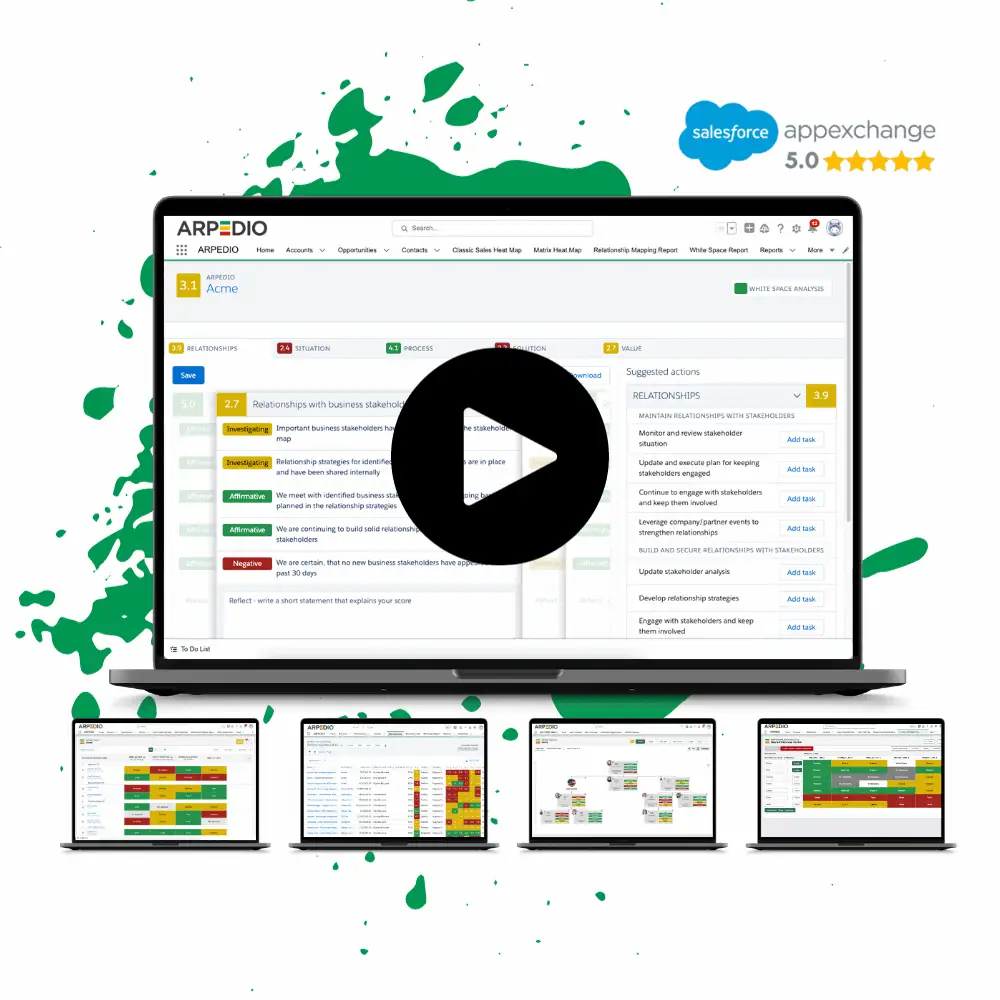MEDDIC is a widely known and used sales process that focuses on better customer qualification. Assessing your prospects based on each step of the MEDDIC framework presents you with the information you need to accurately qualify your leads, letting you efficiently allocate your resources on winning deals. Keep reading to learn everything you need to know about the MEDDIC sales methodology, and how to leverage this framework to stay ahead in your own complex sales process.
Table of Contents
What is the MEDDIC Sales Process?
The MEDDIC sales qualification process is a B2B sales methodology. It was first developed in the 1990s and is used extensively throughout some of the most elite sales organizations across the world. The MEDDIC sales methodology is well-suited for enterprise sales organizations as enterprise sales (almost always) require 1) engagement from numerous stakeholders, and 2) a complex solution to meet their needs. And for this, MEDDIC is ideally suited as a sales qualification process.
In other words, the purpose of the MEDDIC sales process is to achieve better customer qualification. It’s all about determining if a customer is worth your time and effort. If you’re in sales, you already know that turning leads into prospects isn’t easy. It takes time and effort to identify new leads and run them through a qualification process. In a worst case scenario, you end up spending hours on research and outreach before realizing that a potential customer isn’t a match for your business.
So basically, the MEDDIC sales methodology acts as a simple checklist for your sales process. It guarantees you have all the critical information you need, and thanks to the simple acronym, you won’t forget the things you need to learn about your prospecting account.
What Does MEDDIC Stand for?
MEDDIC is an acronym, i.e., an abbreviation formed from the initial letters of other words and pronounced as a word. It stands for Metrics, Economic buyer, Decision criteria, Decision process, Identify pain, and Champion. By assessing your customer based on these six steps, MEDDIC helps you determine if it’s worth your efforts getting a specific customer into your sales funnel. Now, let’s dive into the steps involved in the MEDDIC qualification process.
MEDDIC Step-by-Step
As stated in the previous section, MEDDIC works with six qualification steps. In the following, we’ll take a look at each step in the qualification process.
1. Metrics
The first step of the qualification process focuses on the quantifiable measures of value and has to do with the economic impact of your solution.
Ask your prospect about their specific goal(s) and how they measure success. You need to find out what metrics your customers care about, and what they’re hoping to gain from your solution specifically. These gains should be measurable, e.g., save 25% on machinery downtime. Only when you know the quantifiable goals your prospect is looking to achieve, you can prove the value and ROI of your solution. Thus, you’ll be able to tailor the economic benefits of your solution to match the prospects’ business needs.
2. Economic Buyer
In the second step, you have to find out who has the power to spend money on your business/solution. Who are the financial decision makers? Whether you like it or not, this person will have a say in whether your deal closes or not. So if you can’t reach this person directly, make sure you get all the information about their priorities, goals, expectations, etc. from your point of contact in order to align your selling points with the economic buyer’s motivations.
3. Decision Criteria
Third step has to do with your prospective company’s decision making criteria, i.e., the sets of principles, guidelines and requirements they use to make a decision. Most companies are facing countless (and similar) solutions from various vendors, forcing them to compare and finally select the option that best fits their decision criteria. The decision criteria will vary depending on your solution, but for instance, if you’re selling SaaS solutions, the prospective companies might be looking at criteria such as usability, onboarding, adoption, integration etc. Thus, in order to modify your sales pitch (and overall messaging) to speak to the decision criteria that matter the most to your client, you first need to figure out what they are.
4. Decision Process
In addition to the decision criteria, it’s essential to familiarize yourself with your prospect’s decision process: The internal series of steps that dictate how they make the final decision.
With the customer’s specific decision process in mind, it’s much easier to stay in the loop and ensure your sale doesn’t fall through the cracks. Have your point of contact explain the typical process, find out who’s involved in the important decision meetings, if there’s any specific paperwork required, and what kind of approval process prerequisites a winning deal.
5. Identify Pain
What is the pain the company is trying to solve? No pain, no pursuit for a solution. Easy as that. That’s why it’s absolutely critical to understand the specific need, or what’s causing the pain. And it’s not sufficient to simply know that they need to improve their delivery process. The more specific – e.g., that an ineffective delivery process is costing the company $200.000 a month – the more specific you can tailor your solution. Another effective approach to this step is to paint a picture of the risk (and cost) of doing nothing.
6. Champion
Finally, find yourself a CHAMPION. That one person inside the company who’s rooting for you, has your back, and is pushing for your success. This key player will help you drive the opportunity and – best case scenario – do the selling for you internally. This person should be well-respected within the company, but not necessarily hold a management position.
Now, we’ve clarified each of the six steps of the qualification process, and we hope the purpose of going through them is crystal clear: To be able to pitch your solution in the most specific and compelling way.
What are the Benefits of MEDDIC Methodology?
Still wondering what the benefits of a qualification methodology are? Let’s look at it this way: Are you constantly failing to move the sale across the finish line? Maybe you’ll be happy to hear that this is not necessarily due to your abilities as a sales professional – it could in fact be a question of the customers you’re trying to sell to. And this is really the most significant benefit of the MEDDIC sales methodology: It helps you qualify your target audience. This way you’ll be reassured that you’re spending your ressources on the right people and in the most effective way, allowing you to close sales easier.
Additionally, the MEDDIC framework also:
- Focuses on qualification, leading to increased revenue and more accurate forecasts
- Serves as a checklist, which allows for fast deal assessment and makes it easy to learn and execute
- Reveals gaps, shortening sales cycles and pointing to next best actions
- Ensures a common language among sales teams, easing sales management
Bottom line, the MEDDIC sales qualification process can help you navigate to the right stakeholder, and when you pitch to better qualified prospects, the closing rate will inevitably be higher, and so will the number of closed-won opportunities.
From MEDDIC to MEDDICC to MEDDPICC
The first variation of MEDDIC saw the light of day back in 1995. Since then, technology has evolved rapidly and brought some more strict requirements into the relationship between vendor and customer, including privacy, security, and service level agreements. That’s why – along with the technological development – a variation of MEDDIC has evolved to include two extra letters: MEDDPICC – and thus two additional dimensions to consider when you qualify a prospect or potential buyer.
The latest variation of MEDD(P)IC(C) includes a P for Paper Process and an extra C for Competition. And it makes perfect sense that these two dimensions are called out as their own element: The paper process today is far more complex than it used to be, and the competitive landscape is much more prevalent. Not only due to more contesting solutions from a seller’s point of view, but also because the average buyer is exposed to an immense amount of different opportunities available for them to invest in that will help them reach their goals and overcome their challenges – not to mention the likelihood of the prospecting companies wanting to build their own solution.
Nonetheless, the MEDDIC or MEDDPICC methodology has stood the test of time and is considered one of the most useful sales tools because it’s adaptable and open for sales leaders to implement it in whichever way they see fit in order to boost sales velocity.
Ready to start taking advantage of sales enablement technologies like account-based selling? Ramp up with ARPEDIO’s account-based selling platform.
How to Implement the MEDDIC Sales Methodology
As you can see from the six (or eight) qualification steps (Metrics, Economic buyer, Decision criteria, Decision process, (Paper process) Identify pain, Champion (and Competition), the MEDDIC sales methodology guides you to get the most information about your prospecting customers. And this information is paramount when it’s time to convince them of the value of your offerings. But, how do you get started using the MEDDIC qualifying process?
To implement MEDDIC, it’s important that your sales team is 100% familiar with the company’s buyer personas. Only then can they understand how your offering(s) relates to your ideal customer and start leveraging the MEDDIC framework to sales reach outs. And don’t forget to document your sales conversations. Depending on the specific prospects, the questions will often vary. Therefore, it’s a good idea to visualize the entire process. And by this, we don’t mean just the basic steps of MEDDIC, but how each of these steps look when tailored to your business specifically – without messing with the overall theme of each step, which should of course remain the same.
Another thing you can do – and something we strongly recommend – is automating this process to the extent possible. For instance, you can create templates for discovery calls directly in your CRM, helping salespeople accurately understand and qualify your customers. Ultimately, this will improve your sales success, as it ensures you spend your precious time on the deals that are actually likely to close.
Now, what if we were to tell you that you can get the MEDDIC qualification process directly anchored in ARPEDIO’s Opportunity Management Software without lifting a finger? Pretty cool, huh.
MEDDIC in Salesforce with ARPEDIO
If your sales methodology is based on MEDDIC/MEDDICC/MEDDPICC, or if you want it to be, we’ve integrated MEDDIC’s qualification steps directly into our Opportunity Management Software to make your opportunity assessments a whole lot easier. Now, what exactly does this mean? It means that you have the MEDDIC framework available right at your fingertips for qualifying your customers/opportunities. ARPEDIO’s Opportunity Management Software gives you the possibility to break complex sales cycles down into tangible guides, questions, and tasks – based on the popular MEDDIC framework.
As you learn more about your prospecting customer, you’ll quickly be able to determine whether they are worth your time and resources. And this will ultimately help you forecast more accurately as you won’t be wasting anymore time on unfit leads you’ll never close.
At ARPEDIO, we aim to streamline the complex opportunity management processes and help sales and account professionals qualify and forecast with more precision – directly in Salesforce. With an integrated sales methodology that goes hand in hand with Salesforce, your organization can see more accurate forecasts and higher close rates.

















